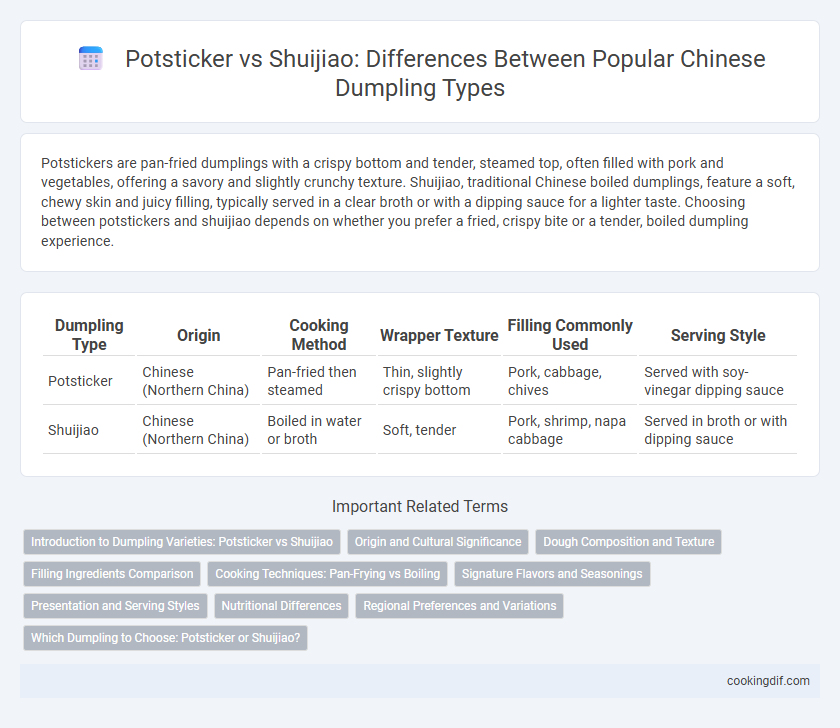Potstickers are pan-fried dumplings with a crispy bottom and tender, steamed top, often filled with pork and vegetables, offering a savory and slightly crunchy texture. Shuijiao, traditional Chinese boiled dumplings, feature a soft, chewy skin and juicy filling, typically served in a clear broth or with a dipping sauce for a lighter taste. Choosing between potstickers and shuijiao depends on whether you prefer a fried, crispy bite or a tender, boiled dumpling experience.
Table of Comparison
| Dumpling Type | Origin | Cooking Method | Wrapper Texture | Filling Commonly Used | Serving Style |
|---|---|---|---|---|---|
| Potsticker | Chinese (Northern China) | Pan-fried then steamed | Thin, slightly crispy bottom | Pork, cabbage, chives | Served with soy-vinegar dipping sauce |
| Shuijiao | Chinese (Northern China) | Boiled in water or broth | Soft, tender | Pork, shrimp, napa cabbage | Served in broth or with dipping sauce |
Introduction to Dumpling Varieties: Potsticker vs Shuijiao
Potstickers, known as guotie in Chinese cuisine, are pan-fried dumplings with a crispy bottom and tender steamed top, typically filled with pork, cabbage, and green onions. Shuijiao, or boiled dumplings, feature a softer texture and are cooked by boiling in water, often containing a pork and chive mixture inside a thin dough wrapper. Both varieties represent distinct regional techniques in dumpling preparation, showcasing diverse textures and flavor profiles in Chinese culinary tradition.
Origin and Cultural Significance
Potstickers, originating from northern China, are pan-fried dumplings known for their crispy bottoms and juicy fillings, symbolizing hospitality and celebration in Chinese cuisine. Shuijiao, traditional boiled dumplings from northern China, especially popular during Lunar New Year, embody family unity and prosperity through their delicate, steamed texture. Both potstickers and shuijiao hold deep cultural significance, representing regional culinary techniques and festive traditions.
Dough Composition and Texture
Potstickers feature a thicker, chewier dough made from a combination of wheat flour and water, allowing them to hold their shape during pan-frying and develop a crispy bottom. Shuijiao dough is generally thinner and smoother, often incorporating a blend of wheat flour and sometimes eggs, resulting in a tender, delicate texture suited for boiling. The composition differences directly influence textural contrasts: potstickers offer a crispy, chewy bite, whereas shuijiao delivers a soft, silky mouthfeel.
Filling Ingredients Comparison
Potstickers typically feature a filling composed of ground pork, cabbage, garlic, and ginger, offering a savory and slightly robust flavor profile. Shuijiao fillings often include a mixture of finely chopped pork, napa cabbage, scallions, and sometimes shrimp, creating a lighter yet aromatic taste. The difference in filling ingredients reflects the regional culinary variations between Northern Chinese potstickers and Northern Chinese boiled dumplings.
Cooking Techniques: Pan-Frying vs Boiling
Potstickers are typically cooked using pan-frying, which creates a crispy golden bottom while steaming the filling to a juicy texture, offering a contrast between crunchy and tender. Shuijiao dumplings are boiled in water or broth, resulting in a soft, delicate skin that envelopes a moist filling, emphasizing tenderness without crispiness. The cooking techniques directly influence texture and flavor, with potstickers delivering a combination of crisp and chewiness, while shuijiao provide a uniform softness.
Signature Flavors and Seasonings
Potstickers feature a crispy bottom with a savory filling often seasoned with ginger, garlic, soy sauce, and sesame oil, offering a robust and slightly smoky flavor profile. Shuijiao dumplings are boiled, resulting in a tender, delicate wrapper that highlights a juicy, aromatic filling typically infused with Chinese chives, ginger, Shaoxing wine, and white pepper. The contrasting cooking methods emphasize potstickers' crunchy texture and intensified seasoning, while shuijiao delivers a softer bite with a fresher, more subtle taste experience.
Presentation and Serving Styles
Potstickers are pan-fried dumplings with a crispy golden bottom and a soft steamed top, typically served on flat plates accompanied by soy-based dipping sauces for an appealing contrast in texture. Shuijiao, Chinese boiled dumplings, present a smooth, translucent dough enveloping the filling, often served in a bowl with a flavorful broth or vinegar-based dipping sauce to enhance the delicate taste. The distinct presentation and serving style of potstickers emphasizes a balance of crispness and tenderness, while shuijiao highlights simplicity and warmth through its boiled preparation.
Nutritional Differences
Potstickers typically contain a pan-fried dough wrapper that increases their calorie and fat content compared to shuijiao, which are boiled dumplings with a softer, lower-fat texture. Shuijiao retain more moisture during cooking, resulting in a lower overall caloric density and less oil absorption. Protein and carbohydrate content remain similar between both, but potstickers often have higher sodium levels due to added frying oils and thicker dough.
Regional Preferences and Variations
Potstickers, originating from Northern China, are typically pan-fried dumplings with a crispy bottom and a chewy top, favored in regions like Beijing for their distinctive texture. Shuijiao, a boiled dumpling popular in Northeastern China, features a tender and soft wrapper that highlights the juicy filling, aligning with local tastes for lighter preparation methods. Regional preferences for potsticker versus shuijiao often reflect climatic conditions and traditional cooking styles, with Northern areas favoring pan-fried varieties for warmth and texture, while colder regions prefer boiled versions for comfort and moisture retention.
Which Dumpling to Choose: Potsticker or Shuijiao?
Potstickers feature a crispy, pan-fried bottom with a tender, steamed top, offering a delightful combination of textures, while shuijiao are fully boiled dumplings known for their soft, smooth skin and juicy filling. Potstickers are ideal for those who enjoy a crunchy contrast and richer flavor from frying, whereas shuijiao suit preferences for a lighter, more delicate taste with a tender wrapper. Choosing between potstickers and shuijiao depends on your desired texture and cooking method, with potstickers providing a savory, crispy bite and shuijiao delivering a gentle, moist dumpling experience.
Potsticker vs Shuijiao for dumpling type Infographic

 cookingdif.com
cookingdif.com